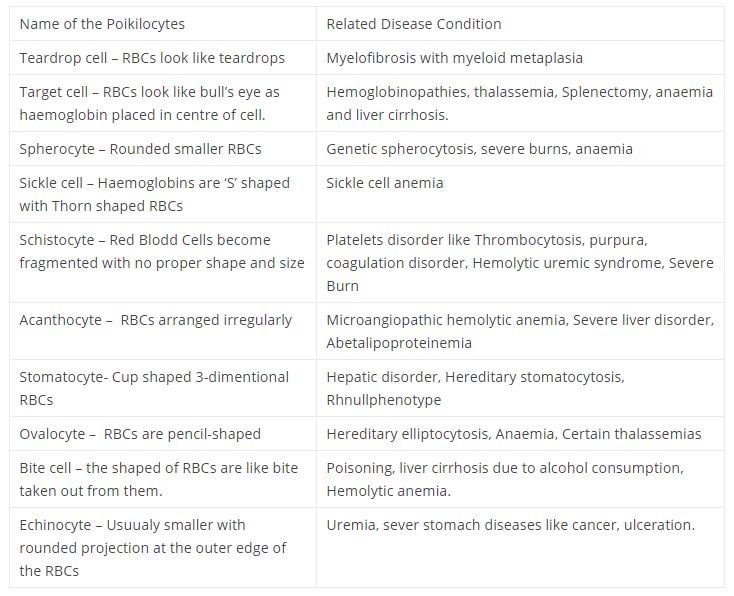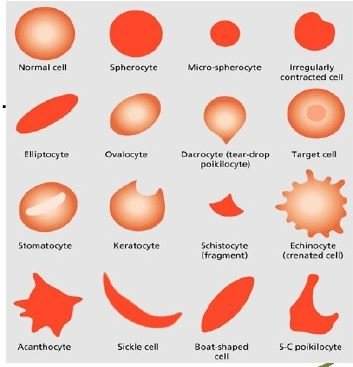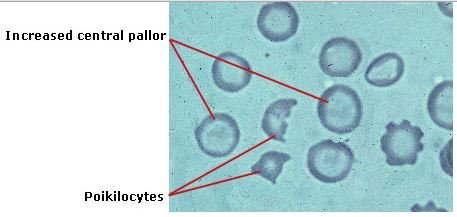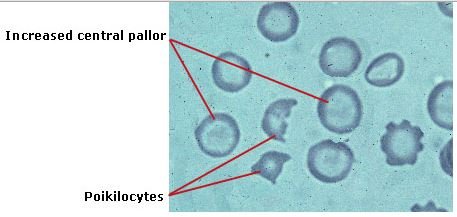Poikilocytosis
Definition of Poikilocytosis
Poikilocytosis is a blood disorder in which ten percent or more red blood cells (RBC’s) are abnormally shaped. These abnormal shaped RBC’s are termed as poikilocytes. The word poikilocyte comes from the Greek word ‘poikilos’ which means varied. Abnormally shaped RBC’s are rare in people. Poikilocytes can be life threatening because they may interfere with blood circulation, transfer of oxygen and the blood nutrient supply.
Poikilocytes are usually found in the blood plasma and work out to about ten percent of the whole blood. There are different types of poikilocytes depending upon their cellular structure and are specifically associated with different disease conditions. [4, 5, 6, 7]
Classification
Membrane Abnormalities

- Spike/Spur Cells or Acanthocytes – Cells have irregularly spiked cell membranes; the related medical conditions are microangiopathic hemolytic anemia, severe liver disorders, vitamin E deficiency, splenectomy, malabsorption, hypothyroidism, neuroacanthocytosis and abetalipoproteinemia.
- Target Cells or Codocytes – Cells look like a bull’s eye with hemoglobin placed in the centre of the cell. The related medical conditions are hemoglobinopathies, thalassemia, splenectomy, iron deficiency anemia, LCAT deficiency, obstructive liver disease and liver cirrhosis.
- Burr Cells or Echinocytes – These cells are usually smaller with short, blunt even spaced projections at the outer edge of the cells. The related medical conditions are uremia, pyruvate kinase deficiency, microangiopathic hemolytic anemia, neonates and severe stomach diseases like cancer or ulceration.
- Spherocytes – These are rounded smaller cells that are sphere shaped; the related medical conditions are genetic spherocytosis, severe burns, newborn jaundice, transfused cells and immune mediated hemolytic anemia.
- Mouth Cells or Stomatocytes- These are cup shaped three dimensional cells that have a central split of pallor that look like kissing lips; the related medical conditions are hepatic disorders, hereditary stomatocytosis, alcoholism and rhnullphenotype.
- Sickle Cells or Drepanocytes – Hemoglobin is ‘S’ shaped with thorn shaped cells; the related medical condition is sickle cell anemia.
- Bite Cells or Degmacytes –Cells are shaped like a bite was taken out from them. The related medical conditions are poisoning, liver cirrhosis due to alcohol consumption, G6PD and hemolytic anemia.

Trauma
- Teardrop Cells or Dacrocytes – Cells look like teardrops with one round end and one more pointed end. The related medical conditions are myelofibrosis with myeloid metaplasia, beta thalassemia major, myelophthistic anemia and extramedullary haematopoiesis.
- Schistocytes – These cells become fragmented with no proper shape or size and look like a piece is broken off. The related medical conditions are platelet disorders like microangiopathic hemolytic thrombocytosis, purpura, coagulation disorder, hemolytic uremic syndrome and severe burns.
- Semilunar Bodies- These are crescent shaped cells and are also called ghost cells/phantom cells due to the loss of all hemoglobin. It is an empty red blood membrane with a dead cell.
- Microspherocytes- These are cells with a smaller diameter than normal but with an increased thickness.
- Pyropoikilocytes- These cells are very sensitive to heat.
- Keratocytes- These cells occur from trauma. These cells ‘blister’ and rupture before becoming keratocytes that look like helmets with straps.

Special Poikilocytes
- Ovalocytes or Elliptocytes – These cells are pencil shaped or egg shaped; the related medical conditions are hereditary elliptocytosis, iron deficiency anemia, other anemia and thalassemias.
Causes
Poikilocytosis is caused by deficiency of vitamin B12 or folic acid. It can also be caused by an underlying medical condition like cancer.
Nutritional Deficiency
Vitamin B12 is necessary for absorption of nutrients into the small intestine. Deficiency of vitamin B12 leads to the poor absorption of folic acid and other essential minerals like iron.
The deficiency of folic acid leads to immature RBC’s. Hemoglobin plays an important role in the maturation of RBC’s and hemoglobin formation. Iron deficiency also hurts the structural development of the hemoglobin. Nutritional deficiency of vitamin B12 and folic acid causes anemia and sometimes it can deform the RBC structures. [1, 4]
Associated Diseases
The associated disease conditions like celiac disease, regional enteritis and tropical sprue which are mainly occur in small intestine and lead to impaired absorption of dietary nutrients specifically folic acids and causes deformed RBCs due to immaturity. Leukaemia is also leads to poikilocytosis.
Symptoms
Normal RBC’s perform some vital biological activities. The main functions of RBC’s are the transportation of oxygen and nutrients to every part of the living tissue which is necessary for normal functioning and overall growth of the body.

Poikilocytosis
In poikilocytosis normal functioning of RBC’s are hampered due to their deformity which leads to:
- Anemia
- Weight loss
- Growth retardation
- Heart diseases
Each associated disease has other specific symptoms. [2]
Diagnosis
Before initiating treatment for poikilocytosis, it is important to know the cause. For diagnosis different blood tests are conducted. The included tests are:
Differential Blood count
- A test where the number of different blood cells is counted and the abnormality may lead to further diagnosis.
Blood Film Test
- A test in which the blood is spread on a slide as a thin film smear and that slide is examined under microscope to determine the shapes of the cells. This test helps to see the structural problems of the RBC’s.
Blood composition test
- A test for the amount of different essential enzymes. Nutrients are also checked to determine any deficiencies.
Hemoglobin Test
- As anemia is a prime symptom of poikilocytosis, hemoglobin percentage analysis is an important test as well.
Other than these general blood tests, doctors may recommend other diagnoses depending upon the findings. [1, 3, 7]
Treatment
After diagnosing the specific reason of poikilocytosis, treatment will be initiated. If the nutrient deficiency is the major reason then a proper diet which contains enough folic acid and vitamin B12 is recommended.
Natural source of Folic Acid and Vitamin B12
Meat products, egg yolks, soya products, lentils, almonds, whole grains, spinach, beet roots, broccoli and cabbage are recommended.
Dietary supplements
If deficiency occurs in vegetarians then different dietary supplements need to supply folic acid and vitamin B12 other than those in found in vegetables.
Gluten free diet
In the case of celiac disease which leads to poikilocytosis, a gluten free diet is essential to control the disease. Other medical procedures may be implemented by the doctor to improve the celiac disease condition.
Chemotherapy
If cancer leads to poikilocytosis, then appropriate cancer chemotherapy helps to control poikilocytosis. [3, 7]
Prognosis
People diagnosed with poikilocytosis need diet and supplement changes due to the lacking nutrients and vitamins. These changes will help the problem. If the cause of poikilocytosis is something other than from a lack of nutrients then another approach needs to be taken. Prognosis will depend on the root cause of the issue. [7]
Reference List:
- Poikilocytosis.net, Available from: http://poikilocytosis.net/blood-test-and-poikilocytosis/
- Right Diagnosis, Available from: http://www.rightdiagnosis.com/h/hereditary_pyropoikilocytosis/symptoms.htm
- Medialab, Available from: https://www.medialabinc.net/red-cell-disorders.aspx
- Medical Treasure, Available from: http://medicaltreasure.com/poikilocytosis/
- Wikipedia, Available from: https://en.wikipedia.org/wiki/Poikilocytosis
- National Center for Biotechnology Information, US National Library of Medicine, Available from: https://www.ncbi.nlm.nih.gov/books/NBK263/
- Health Benefits of Net, Available from: http://health-benefits-of.net/poikilocytosis-definition-causes-symptoms-treatment.html
- The Art of Medicine, Available from: https://theartofmed.wordpress.com/2015/09/05/morphological-abnormalities-of-red-blood-cells/
